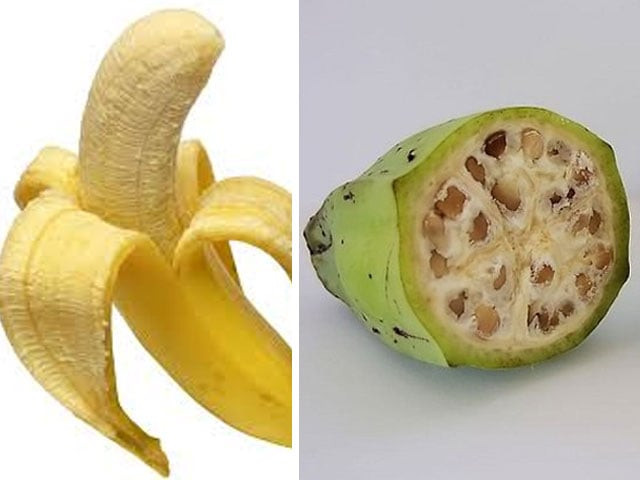These 7 fruits and vegetables look nothing like they used to before
And humans are to blame

Humans have been tweaking the genetics of our favorite produce for millennia.
PHOTO: FILE
Humans have been genetically modifying natural produce for centuries, resulting in the alteration of appearances and tastes of many common fruits and vegetables.
"Genetically modified foods, or GMOs, inspire strong reactions nowadays, but humans have been tweaking the genetics of our favorite produce for millennia," Tanya Lewis writes in Business Insider.
Check out these seven foods that look drastically different now:
1. Corn
 Just your average corn. PHOTO: MIKE LICHT
Just your average corn. PHOTO: MIKE LICHTThe corn that we are so accustomed to seeing on every roadside thela wasn't always like this.
"Despite its abundance and importance, the biological origin of maize has been a long-running mystery," says The New York Times.
It was linked to a Mexican grass called 'teosinte' by some scientists, but George W Beadle was the one who proved that the two had similar genetics and that the teosinte kernels also popped, establishing the close link between the two plants.
 The ancestor of the corn -- teosinte. PHOTO: SHAW WOODS OUTDOOR EDUCATION CENTRE
The ancestor of the corn -- teosinte. PHOTO: SHAW WOODS OUTDOOR EDUCATION CENTRESeason’s delight: 8 Incredible benefits of the humble ‘amrood’
2. Watermelon
 The watermelon of today. PHOTO: AFRICA STUDIO
The watermelon of today. PHOTO: AFRICA STUDIOThe red, juicy watermelon that is a favourite for summer months wasn't always red! National Geographic reports that it has been around for millennia -- some watermelon seeds were found at a 5000-year-old settlement in Libya.
Egyptian tombs that date back to 4000 years also revealed paintings of watermelons that looked pale and more seedy:
 Giovanni Stanchi’s 'Watermelons, peaches, pears and other fruit in a landscape' (1645-1672). PHOTO: CHRISTI'S
Giovanni Stanchi’s 'Watermelons, peaches, pears and other fruit in a landscape' (1645-1672). PHOTO: CHRISTI'S3. Banana
 The very convenient bananas of today. PHOTO: JSTER91
The very convenient bananas of today. PHOTO: JSTER91What if we told you bananas used to have seeds in them? Unbelievable, right? Well, it's true.
A study of the banana family revealed that they evolved from two varieties: Musa acuminata and Musa balbisiana, one bred to produce seedless fruit and the other had large seeds.
 The wild banana with seeds -- Musa balbisiana. PHOTO: WARUT ROONGUTHAI
The wild banana with seeds -- Musa balbisiana. PHOTO: WARUT ROONGUTHAISqueezed dry: Oranges, a winter staple, dwindling in numbers in Swat
4. Carrot
 Modern day carrots. PHOTO: VERZO
Modern day carrots. PHOTO: VERZOThe bright orange carrots are a household commonality, loved by many. They weren't however, always so pleasing to the eye.
According to the World Carrot Museum, ancient Greeks and Romans also grew carrots, but they were thin and purple or off-white in colour with forked roots.
 These wild carrots of today resemble their ancestors. PHOTO: WORLD CARROT MUSEUM
These wild carrots of today resemble their ancestors. PHOTO: WORLD CARROT MUSEUM5. Apple
 Good old apples. PHOTO: MARKUS MAINKA
Good old apples. PHOTO: MARKUS MAINKAThe apple looks similar to what it used to be, but its taste has changed a lot over the years.
It comes from the Asian wild apple, Malus sieversii that grows in Kazakhstan, Kyrgyzstan, Tajikistan, Uzbekistan and China. This apple is small and sour in taste.
 The Asian wild apple loks more like a guava. PHOTO: GLOBAL TREES CAMPAIGN
The Asian wild apple loks more like a guava. PHOTO: GLOBAL TREES CAMPAIGN7 foods to ease an upset stomach
6. Tomato
 Today's juicy tomatoes are used in literally every dish. PHOTO: KAROL FRANKS
Today's juicy tomatoes are used in literally every dish. PHOTO: KAROL FRANKSIt took a while for this fruit to become common. It used to be tiny and green or yellow in colour when used by the Aztecs, and was later brought to Spain and Italy by explorers.
In the 1700s, people called it 'poison apple' because they thought it killed aristocrats, according to Smithsonian. This was later proved to be false, of course.
 This herbarium sheet shows the oldest conserved tomato plants of Europe, circa 1542-1544. PHOTO: NATURALIS BIODIVERSITY CENTER
This herbarium sheet shows the oldest conserved tomato plants of Europe, circa 1542-1544. PHOTO: NATURALIS BIODIVERSITY CENTER7. Eggplant
 Today's deep purple eggplants. PHOTO: VALENTSOVA
Today's deep purple eggplants. PHOTO: VALENTSOVAEggplants weren't always purple in colour! In fact, they got their name because they used to be white and round, like an egg, and some even had spines. Overtime they developed yellow, azure and purple hues as well.
Authors of the article History and Iconography of Eggplant say, "Several Sanskrit documents, dated from as early as 300BCE, mention this plant with various descriptive words, which suggest its wide popularity as food and medicine."
 Wild eggplants still come in a variety of unusual colors, much like their ancestors. PHOTO: WHOLOGWHY
Wild eggplants still come in a variety of unusual colors, much like their ancestors. PHOTO: WHOLOGWHYThis article originally appeared on mother nature network.



















COMMENTS
Comments are moderated and generally will be posted if they are on-topic and not abusive.
For more information, please see our Comments FAQ